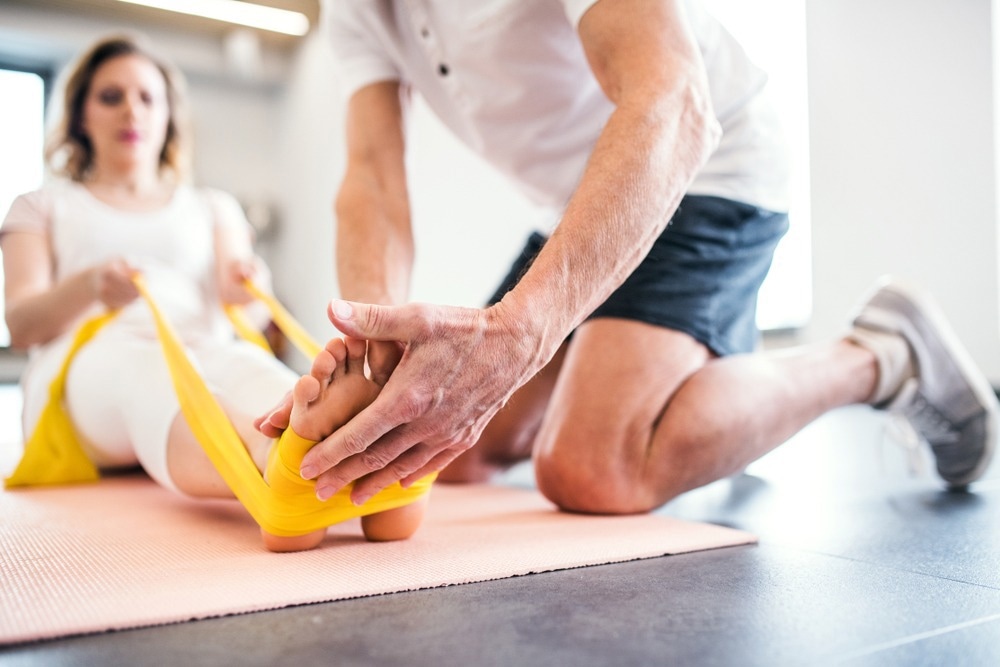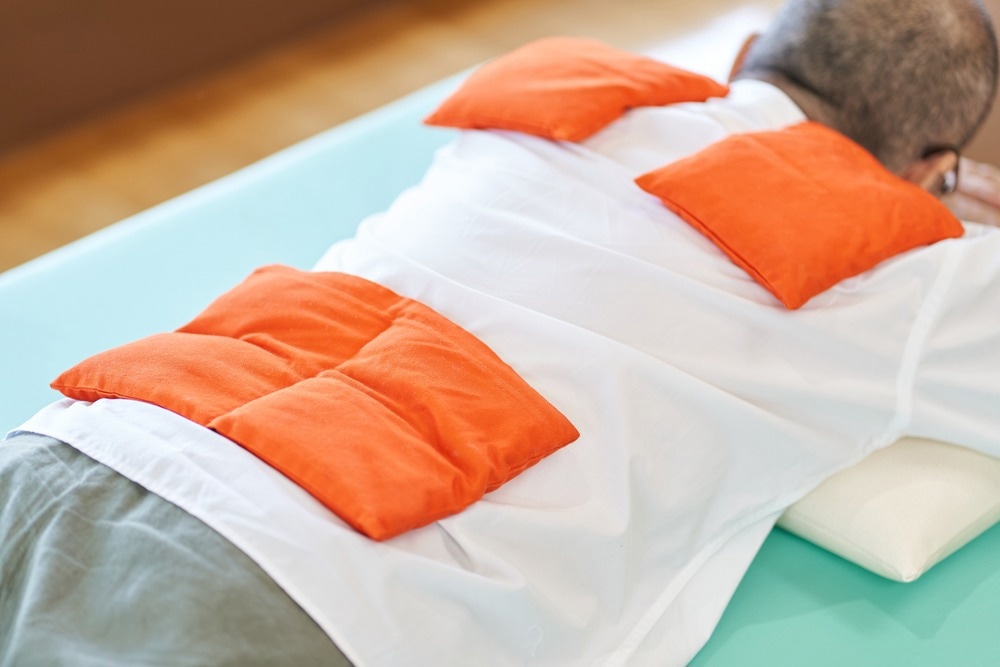Understanding mechanotherapy
Mechanotherapy in rehabilitation
Mechanotherapy vs traditional pharmacological approaches
Emerging technologies in mechanotherapy
Conclusion
References
Further reading
Mechanotherapy is an umbrella term for non-conventional physical therapy modalities that exploit mechanobiology principles for tissue rehabilitation and regeneration of tissues. It acts via the application of tailored mechanical forces.

Image Credit: Ground Picture/Shutterstock.com
While mechanical interventions have been used for thousands of years, scientists trace formal physical medicine back to only a couple of hundred years ago. Mechanotherapy was then a descriptive term for exercise and physical manipulation. However, its perception has changed from being a purely mechanical modality to recognizing the role played by tissue responses to physical forces in injured vs healthy tissues.
Mechanotherapy is used in rehabilitation and regenerative medicine, including post-injury, post-cancer, and post-surgical restoration of function. Some common applications include microdeformation, shock wave therapy (SWT), distraction osteogenesis, and surgical tissue reduction.
Understanding mechanotherapy
Mechanical forces regulate cell activity and thus promote the growth, development, organization, and repair of tissues from the earliest days of life. Thus, they can be used to induce adaptive cellular and tissue responses, including stem cell differentiation into various lineages. The type of response varies with the timing, type of force, and characteristics of the ECM.
Musculoskeletal cells and tissues not only bear loads but generate, absorb, and transmit forces to produce locomotion. The aim of mechanotherapy is to use tailored, timely physical stimulation of specific musculoskeletal tissues to trigger specific biological pathways.
This is termed mechanotransduction, defined as “the conversion of a biophysical force into a cellular and molecular response.”
The ECM-integrin-cytoskeleton axis is critical in mechanotherapy. Cells lie within an extracellular matrix (ECM) equipped with transmembrane receptors called integrins. These are mechanosensors that transmit forces on the ECM to the cytoskeleton.
This, in turn, undergoes shifts in its dynamic compression-tension balance, or tensegrity, causing altered gene transcription. This may happen via direct nuclear connections or indirect biochemical pathways.
Force-sensitive transmembrane proteins may also trigger mechanoreceptor-induced signaling pathways that regulate gene expression.
There are multiple types of therapeutic mechanical stimuli, from massage to exercise therapy or ultrasound. Mechanotherapy includes externally or internally applied forces, as with joint mobilization or exercise therapy, respectively. Common mechanotherapies include joint mobilizations, muscle or tendon stretching, resistance exercises, vibration platforms, interventional ultrasound, and massage.
Low-intensity pulsed ultrasound (LIPUS) may stimulate cartilage and bone growth, as well as MSC differentiation, via ion channels on the cell surface, accelerating bone healing by up to ~40%.
Dynamic compression may increase growth and strength within engineered cartilage grafts by altering membrane strain in the mesenchymal stem cells (MSC) within the bone marrow.
Osteocytes in the bone matrix are stimulated by fluid shear forces during mechanical loading, eventually causing altered intramedullary pressure. This could be replicated in time to generate adaptive anabolic changes in non-loaded bone for rehabilitation.
“The ultimate aim of these technologies is to stimulate the body through mechanical intervention replicative of exercise.” The result could be callus formation, wound closure, or increased cortical bone thickness, promoting healing
Mechanotherapy in rehabilitation
Mechanotherapy includes physical activity, as in daily work-home activities, and flexibility/strengthening exercises to limit pain and stiffness in musculoskeletal conditions. The former, coupled with weight management, apply or reduce mechanical force on affected musculoskeletal tissues, respectively.
Targeted stimulation of musculoskeletal cells such as muscle, tendon, articular cartilage, and bone can produce additive or synergistic effects resulting in regeneration and restoration of function. Rather than a deterrent to healing, early mobilization and/or ambulation or joint loading facilitates healing and integration of implants and engineered tissues.
Exercise therapy, namely, strength training, range of motion exercises, aerobics, and passive joint movement, reduces joint loading and restores function while relieving pain. This is by improving muscle strength, while muscles passing across a joint absorb most of the loading-associated torque.

Image Credit: mapo_japan/Shutterstock.com
Heat therapy and tissue loading, during exercise or by intermittent compression via an inflatable pneumatic cuff, promote delayed remodeling and improve fracture healing with higher strength and range of motion (ROM) compared to standard treatment, including exercise. Joint physiology in osteoarthritis patients improves with physical therapy intervention after anterior cruciate ligament reconstruction and total knee replacement.
Acutely painful tissues benefit from cryotherapy, taping, bracing, and extracorporeal SWT. Along with lateral heel wedges, walking aids, and valgus bracing, these are designed to offload injured or diseased joints, relieve muscle spasms, limit disease progression, and improve outcomes.
Conversely, resistance training and restriction of blood flow regulate neovascular growth in chronic inflammation.
Joint mobilization involves repeated slow passive movements. Joint manipulation refers to rapid, forceful movements at the limits of joint’s ROM. Though non-standardized, such manual therapy is superior to current standards of care, with or without exercise therapy.
Animal studies show that immediate post-exercise massage promotes recovery after eccentric exercise, with massive increases in peak torque recovery and significant immunomodulatory effects. With disuse atrophy and in aged skeletal muscle, massage decreases the expected reduction in protein synthesis.
Massage of one limb benefits contralateral muscle mass gain and function in an injured limb.
New modalities like Pulsed Electromagnetic Fields (PEMF) and focused ESWT (fESWT) appear to relieve pain, break down calcifications, and promote tissue regeneration and tissue remodeling. The latter is employed in conditions such as rotator cuff calcific tendinitis, osteonecrosis of the femoral head, and plantar fasciitis, as well as post-cancer and post-injury/post-surgical therapy to restore active exercise capacity.
Mechanotherapy vs traditional pharmacological approaches
“Both pharmacological, non-pharmacological, as well as interventional pain therapy are important to enhance patient’s recovery, well-being, and improve quality of life.”
Pharmacologic options include pain-relievers and anti-inflammatories like non-steroidal anti-inflammatory drugs (NSAIDs), intra-articular injections, topical analgesics, and centrally-acting drugs like duloxetine and opioids. These have lower efficacy, significant adverse effects, and short-term action and are sometimes addictive. They are more toxic in older people who are more prone to musculoskeletal conditions.
Conversely, some drugs may improve anabolic tissue response to mechanotherapy. For instance, physical stimulation produces a supra-summative increase in bone adaptation at peak levels of receptor sensitization by parathyroid hormone (PTH) therapy.
Some drugs interact adversely with mechanotherapy. For instance, NSAID administration prior to joint loading disrupts prostaglandin release, reducing collagen synthesis and ECM formation, resulting in suboptimal responses.
Non-pharmacological approaches show advantages in certain conditions. In most musculoskeletal conditions, like osteoarthritis and muscle pain following injury or exercise, this is the first line of treatment. These have no severe side effects, have long-term benefits, and address multiple sources of pain and/or disability.
Holistic approaches comprising weight management, stress relief, and mechanotherapy, taking into consideration the patient’s wishes and other medical conditions, show long-term and wide-ranging benefits while avoiding the risks and ineffectiveness that often accompany medication use.
Emerging technologies in mechanotherapy
Tensegrity-based soft robotics has resulted in engineered materials like magnetic ferrogels for massage and soft compressive sleeves for cardiovascular conditions. These show dynamically changing force application and compliance when deformed.
Advances in tissue engineering (3D printing, soft robotics, engineered active biomaterials, and synthetic ECM) may improve actuation systems for mechanotherapy. With better analytic methods, this could improve the quality and extent of regenerative studies. Examples include the development of organs-on-chips.
Recent research suggests the possibility of producing vascular systems infiltrating 3D-engineered tissues, ready for drug and treatment trials. Drugs like Rho kinase (ROCK) inhibitors that act on myosin light chains could drive multiple mechanotherapy applications as well.
Conclusion
The human body constantly and dynamically transmits forces through the musculoskeletal system, while adaptive biological remodeling proceeds in response to the mechanical forces of the environment. The use of mechanotherapy is thus a powerful tool to change metabolism at the cellular and tissue levels.
Research on the how and where of mechanical stimulation, coupled with an improved understanding of mechanobiology, will help accelerate and improve healing and rehabilitation at all stages of the life cycle. This could be by recruiting and directing stem cells towards targeted lineages, regenerating new tissue, and promoting tissue remodeling post-injury to exceed the original strength.
References
- Thompson, W. R. et al. (2016). Understanding mechanobiology: physical therapists as a force in mechanotherapy and musculoskeletal regenerative rehabilitation. Physical Therapy and Rehabilitation Journal. doi: https://doi.org/10.2522/ptj.20150224. https://academic.oup.com/ptj/article/96/4/560/2686523.
- Warden, S. J. et al. (2017). Become one with the force: optimising mechanotherapy through an understanding of mechanobiology. British Journal of Sports Medicine. doi: https://doi.org/10.1136%2Fbjsports-2017-097634. https://www.ncbi.nlm.nih.gov/pmc/articles/PMC5546094/.
- Ng, J. L. et al. (2017). Establishing the basis for mechanobiology-based physical therapy protocols to potentiate cellular healing and tissue regeneration. Frontiers in Physiology. doi: https://doi.org/10.3389/fphys.2017.00303. https://www.frontiersin.org/articles/10.3389/fphys.2017.00303/full.
- Ingber, D. E. (2023). From tensegrity to human organs-on-chips: implications for mechanobiology and mechanotherapeutics. Biochemical Journal. doi: https://doi.org/10.1042%2FBCJ20220303. https://www.ncbi.nlm.nih.gov/pmc/articles/PMC9987949/.
- Loghmani M. T. et al. (2016) Soft tissue manipulation: a powerful form of mechanotherapy. Physiotherapy and Rehabilitation. doi: 10.4172/2573-0312.1000122.
- Seo, B. R. et al. (2022). Recent and future strategies of mechanotherapy for tissue regenerative rehabilitation. ACS Biomaterials Sciences and Engineering. doi: 10.1021/acsbiomaterials.1c01477. https://pubmed.ncbi.nlm.nih.gov/35133789/.
- Liu, S. et al. (2023). Mechanotherapy in oncology: Targeting nuclear mechanics and mechanotransduction . Advanced Drug Delivery Review. doi: https://doi.org/10.1016/j.addr.2023.114722. https://pubmed.ncbi.nlm.nih.gov/36738968/.
- Khan, K. M. et al. (2009). Mechanotherapy: how physical therapists’ prescription of exercise promotes tissue repair. British Journal of Sports Medicine. doi: https://doi.org/10.1136%2Fbjsm.2008.054239. https://www.ncbi.nlm.nih.gov/pmc/articles/PMC2662433/.
- Clinical Management of OA (2023). https://oaaction.unc.edu/oa-module/oa-treatment/.
- El-Tallawy, S. N. et al. (2021). Management of musculoskeletal pain: an update with emphasis on chronic musculoskeletal pain. Pain Therapy. doi: https://doi.org/10.1007%2Fs40122-021-00235-2. https://www.ncbi.nlm.nih.gov/pmc/articles/PMC8119532/.
- McKay, J. et al. (2021). Mechanobiology-based physical therapy and rehabilitation after orthobiologic interventions: a narrative review. International Orthopedics. doi: https://doi.org/10.1007/s00264-021-05253-5. https://link.springer.com/article/10.1007/s00264-021-05253-5.
- Brownell, L. (2024). Massage doesn’t just make muscles feel better, it makes them heal faster and stronger. https://seas.harvard.edu/news/2021/10/massage-doesnt-just-make-muscles-feel-better-it-makes-them-heal-faster-and-stronger.
- Crevenna, R. et al. (2021). Focused extracorporeal shockwave therapy in physical medicine and rehabilitation. Current Physical Medicine and Rehabilitation Reports. doi: https://doi.org/10.1007/s40141-020-00306-z. https://link.springer.com/article/10.1007/s40141-020-00306-z.
Further Reading
Last Updated: Jan 22, 2024